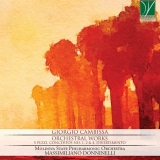Der u.a. von Karajan und Celibidache ausgebildete italienische Dirigent Giorgio Cambissa (1921-1998) war auch Direktor der Konservatorien in Bolzano und Rom und ebenfalls als Komponist tätig. Im Opernland Italien komponierte er vor allem Orchestermusik und Kammermusik. Stilistisch kann man ihn als sehr kosmopolitisch bezeichnen, mit Einflüssen von Ravel, Bartok, Stravinsky und Prokofiev. Zusammen mit viel Sensibilität für Klangschönheit und wohlstrukturierte Formen entstand so eine interessante, klanglich ausgefeilte Musik.
Das 1952 entstandene Werk Cinque Pezzi per Orchestra ist eine Suite aus dem Ballett La Favola della Bella Addormentata nel Bosco. Die fünf Tableaux sind phantasievoll komponiert, sehr farbig und rhythmisch von großem Raffinement.
Die drei Orchesterkonzerte zeugen ebenfalls von einem sicheren und sorgfältigen kompositorischen Talent. Sie sind wirklich originell und wegen ihrer Ideenfülle attraktiv.
Das Divertimento per Orchestra (1950) ist ein ebenso fein elaboriertes Werk mit vielen verschiedenen Themen, die entweder lyrisch oder rhythmisch vital entwickelt werden.
Auffallend an Cambissas Musik ist neben der feinen Ausarbeitung, den vielen Farben und interessanter Rhythmik die oft sich darin äußernde Schwermut, die selbst Teile des Divertimentos belastet, obschon dieses Werk generell sehr vital und lichtvoll ist. Bei Cambissa hat man den Eindruck, dass die Ideen, die er verarbeitet, in gewisser Weise dem ‘Erfinden’ von Musik gleichkommt, also Teil eines gedanklichen Prozesses ist, der mit Skulptur zu vergleichen ist, für die der Komponist übrigens eine große Liebe hatte. Ja, seine Werke sind sozusagen musikalische Skulpturen.
























